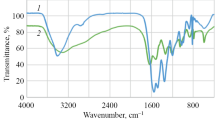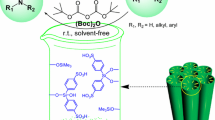Abstract
Trifluoromethyl defluorination reaction plays a crucial role in promoting drug discovery, pesticide development and materials science. However, achieving C–F bond cleavage over heterogeneous catalysts remains a great challenge. Herein, we use methanol as the defluorocarbonylation reagent and silicon-aluminum phosphate mesoporous materials (named P–xSi–Al2O3, where x represents the Si–Al2O3 ratio) as the heterogeneous defluorination catalysts, successfully convert trifluorotoluene to methyl benzoate (Conv. 89.57%, Sel. 87.37%). Detailed investigations revealed that the acidity as well as the Lewis/Brønsted acid site of the catalyst promote the defluorination process. Meanwhile, the mesoporous structure of sheet-like fibers makes active sites easier to access the substrates, which results in an excellent performance. The defluorination reaction can be realized without solvent, noble metal and excessive acid additives over the present catalytic system and the good substrate universality in the carbonylation reaction of halogen-containing aromatic hydrocarbons reveal great potential for practical dehalogenation and carbonylation reaction.
Graphical Abstract














Similar content being viewed by others
Data availability
All data analyzed or generated during this work are included in this manuscript and its supporting information file. The supporting information including different experimental conditions, SEM images, XRD spectra, reused catalysts images and GC–MS figures, etc.
References
Zhu J, Perez M, Caputo CB, Stephan DW (2016) Use of trifluoromethyl groups for catalytic benzylation and alkylation with subsequent hydrodefluorination. Angew Chem Int Ed 55:1417–1421. https://doi.org/10.1002/anie.201510494
Wang HY, Wan Y (2009) Synthesis of ordered mesoporous Pd/carbon catalyst with bimodal pores and its application in water-mediated Ullmann coupling reaction of chlorobenzene. J Mater Sci 44:6553–6562. https://doi.org/10.1007/s10853-009-3612-7
Wang J, Sanchez-Rosello M, Acena JL, del Pozo C, Sorochinsky AE, Fustero S, Soloshonok VA, Liu H (2014) Fluorine in pharmaceutical industry: fluorine-containing drugs introduced to the market in the last decade. Chem Rev 114:2432–2506. https://doi.org/10.1021/cr4002879
Chu XQ, Sun LW, Chen YL, Chen JW, Ying X, Ma MT, Shen ZL (2022) HP(O)Ph2/H2O-promoted hydrodefluorination of trifluoromethyl alkenes. Green Chem 24:2777–2782. https://doi.org/10.1039/D1GC04645D
Ahrens L, Bundschuh M (2014) Fate and effects of poly- and perfluoroalkyl substances in the aquatic environment. Rev Environ Toxicol Chem 33:1921–1929. https://doi.org/10.1002/etc.2663
Young CJ, Mabury SA (2010) Atmospheric perfluorinated acid precursors: chemistry, occurrence, and impacts. In: Reviews of environmental contamination and toxicology, vol 208. Springer, New York. https://doi.org/10.1007/978-1-4419-6880-7_1
Kethe A, Tracy AF, Klumpp DA (2011) Protolytic defluorination of trifluoromethyl-substituted arenes. Org Biomol Chem 9:4545–4549. https://doi.org/10.1039/C0OB01276A
Fuchibe K, Akiyama T (2006) Low-valent niobium-mediated double activation of C−F/C−H bonds: fluorene synthesis from o-Arylated α, α, α-trifluorotoluene derivatives. J Am Chem Soc 128:1434–1435. https://doi.org/10.1021/ja0565323
Grushin VV (2010) The organometallic fluorine chemistry of palladium and rhodium: studies toward aromatic fluorination. Acc Chem Res 43:160–171. https://doi.org/10.1021/ar9001763
Kraft BM, Lachicotte RJ, Jones WD (2001) Aliphatic and aromatic carbon−fluorine bond activation with Cp*2ZrH2: mechanisms of hydrodefluorination. J Am Chem Soc 123:10973–10979. https://doi.org/10.1021/ja016087l
Brennfuhrer A, Neumann H, Beller M (2009) Palladium-catalyzed carbonylation reactions of aryl halides and related compounds. Angew Chem Int Ed 48:4114–4133. https://doi.org/10.1002/anie.200900013
Magerlein W, Indolese AF, Beller M (2002) Development of new palladium catalysts for the alkoxycarbonylation of aryl chlorides. J Organomet Chem 641:30–40. https://doi.org/10.1016/S0022-328X(01)01293-1
KunTZE-Fechner MW, Verplancke H, Tendera L, Diefenbach M, Krummenacher I, Braunschweig H, Marder TB, Holthausen MC, Radius U (2020) Coligand role in the NHC nickel catalyzed C–F bond activation: investigations on the insertion of bis(NHC) nickel into the C–F bond of hexafluorobenzene. Chem Sci 11:11009–11023. https://doi.org/10.1039/D0SC04237D
Lin Q, Yang CF, Jiang WD, Chen H, Li XJ (2007) Carbonylation of iodobenzene catalyzed by water-soluble palladium–phosphine complexes in ionic liquid. J Mol Catlal A Chem 264:17–21. https://doi.org/10.1016/j.molcata.2006.08.059
Liu SJ, Wang HL, Dai XC, Shi F (2018) Organic ligand-free carbonylation reactions with unsupported bulk Pd as catalyst. Green Chem 20:3457–3462. https://doi.org/10.1039/C8GC00740C
Peng JB, Geng HQ, Wu XF (2019) The chemistry of CO. Carbonylation Chem 5:526–552. https://doi.org/10.1016/j.chempr.2018.11.006
Wang F, Hu JB (2009) Brønsted acid mediated (sp3)carbon-fluorine bond activation: inter- and intramolecular arylation of trifluoromethylated arenes. Chin J Chem 27:93–98. https://doi.org/10.1002/cjoc.200990032
Guo YQ, Wang RG, Song HJ, Liu YX, Wang QM (2020) Visible-light-induced deoxygenation/defluorination protocol for synthesis of γ, γ-difluoroallylic ketones. Org Lett 22:709–713. https://doi.org/10.1021/acs.orglett.9b04504
Moore JT, Dorantes MJ, Zihan PM, Schwartz TM, Schaffner J, Apps SL, Gaggioli CA, Das U, Gagliardi L, Blank DA, Lu CC (2022) Light-driven hydrodefluorination of electron-rich aryl fluorides by an anionic rhodium-gallium photoredox catalyst. Angew Chem Int Ed 42:e202205575. https://doi.org/10.1002/anie.202205575
Wu PF, Yang M, Pang JF, Fan D, Song L, Sun TT, Zheng MY, Tian P, Zhang T (2023) Facile synthesis of SAPO-34 nanocrystallites with excellent performance for the dehydration of carbohydrates to 5-hydroxymethylfurfural. Green Chem 25:1395–1405. https://doi.org/10.1039/D2GC04301G
Xie T, Ding J, Shang XF, Zhang XQ, Zhang Q (2023) Effective synergies in indium oxide loaded with zirconia mixed with silicoaluminophosphate molecular sieve number 34 catalysts for carbon dioxide hydrogenation to lower olefins. J Colloid Interface Sci 635:148–158. https://doi.org/10.1016/j.jcis.2022.12.086
Tao S, Zhang XY, Li X, Wang YJ, Wang B, Yuan YY, Zhang DQ, Du SR, Li XL (2023) Hierarchical low-silica SAPO-34 with enhanced MTO performance: mesopore template- and fluoride-free synthesis. Microporous Mesoporous Mater 349:112425. https://doi.org/10.1016/j.micromeso.2022.112425
Chen YY, Yi XF, Li CB, Sun XY, Zheng AM (2018) Brønsted/Lewis acid sites synergistically promote the initial C–C bond formation in the MTO reaction. Chem Sci 9:6470–6479. https://doi.org/10.1039/C8SC02302F
Ge LX, Li WT, Li SG, Li G, Li WQ, Qiu MH, Chen XQ (2022) Designed synthesis of single-crystalline silicoaluminophosphate zeolite via interzeolite transformation for n-dodecane hydroisomerization. Microporous Mesoporous Mater 330:111568. https://doi.org/10.1016/j.micromeso.2021.111568
Chen YK, Hsieh CH, Wang WC (2020) The production of renewable aviation fuel from waste cooking oil. Part II: catalytic hydro-cracking/isomerization of hydro-processed alkanes into jet fuel range products. Renew Energ 157:731–740. https://doi.org/10.1016/j.renene.2020.04.154
Lok BM, Messina CA, Patton RL, Gajek RT, Cannan TR, Flanigen EM, Wilson ST (1984) Silicoaluminophosphate molecular sieves: another new class of microporous crystalline inorganic solids. J Am Chem Soc 106:6092–6093. https://doi.org/10.1021/ja00332a063
Zhao GL, Teng JW, Xie ZK, Jin WQ, Yang WM, Chen QL, Tang Y (2007) Effect of phosphorus on HZSM-5 catalyst for C4-olefin cracking reactions to produce propylene. J Catal 248:29–37. https://doi.org/10.1016/j.jcat.2007.02.027
Nie LH, Meng AY, Yu JG, Jaroniec M (2013) Hierarchically macro-mesoporous Pt/γ-Al2O3 composite microspheres for efficient formaldehyde oxidation at room temperature. Sci Rep 3:3215–3220. https://doi.org/10.1038/srep03215
Wang X, Tian JS, Zheng YH, Xu XL, Liu WM, Fang XZ (2014) Tuning Al2O3 surface with SnO2 to prepare improved supports for Pd for CO oxidation. ChemCatChem 6:1604–1611. https://doi.org/10.1002/cctc.201402052
Tang MZ, Wang ZY, Wang YS, Bao WJ, Yang G, Sun Y (2022) Characterization of the impurity phases in phosphogypsum by the EBSD-XPS method. Off Spectrosc Spectr Anal 42:136–140. https://doi.org/10.3964/j.issn.1000-0593(2022)01-0136-05
Ramanavicius S, Ramanavicius A (2020) Progress and insights in the application of MXenes as new 2D nano-materials suitable for biosensors and biofuel cell design. Int J Mol Sci 21:9224–9240. https://doi.org/10.3390/ijms21239224
Naguib M, Gogotsi Y (2015) Synthesis of two-dimensional materials by selective extraction. Acc Chem Res 48:128–135. https://doi.org/10.1021/ar500346b
Miyamoto T, Katada N, Kim JH, Niwa M (1998) Acidic property of MFI-type gallosilicate determined by temperature-programmed desorption of ammonia. J Phys Chem B 102:6738–6745. https://doi.org/10.1021/jp980007r
Topsoe NY, Pedersen K, Derouane EG (1981) Infrared and temperature-programmed desorption study of the acidic properties of ZSM-5-type zeolites. J Catal 70:41–52. https://doi.org/10.1016/0021-9517(81)90315-8
Xue NH, Chen XK, Nie L, Guo XF, Ding WP, Chen Y, Gu M, Xie ZK (2017) Understanding the enhancement of catalytic performance for olefin cracking: hydrothermally stable acids in P/HZSM-5. J Catal 248:20–28. https://doi.org/10.1016/j.jcat.2007.02.022
Wang XX, Guo F, Wei XX, Liu ZM, Zhang W, Guo SQ, Zhao LF (2016) The catalytic performance of methylation of naphthalene with methanol over SAPO-11 zeolites synthesized with different Si content. Korean J Chem Eng 33:2034–2041. https://doi.org/10.1007/s11814-016-0065-y
Li D, Li F, Ren J, Sun YH (2003) Rare earth-modified bifunctional Ni/HY catalysts. Appl Catal A Gen 241:15–24. https://doi.org/10.1016/S0926-860X(02)00454-4
Liu M, Wu W, Kikhtyanin OV, Xiao LF, Toktarev AV, Wang GL, Zhao AJ, Smirnova MY, Echevsky GV (2013) Alkylation of naphthalene with methanol over SAPO-11 molecular sieve synthesized by different crystallization methods. Microporous Mesoporous Mater 181:132–140. https://doi.org/10.1016/j.micromeso.2013.06.034
Yamaguchi A, Jin DF, Ideda T, Sato K, Hiyoshi N, Hanaoka T, Mizukami F, Shirai M (2014) P-ZSM-5 pretreated by high-temperature calcination as durable catalysts for steam cracking of n-hexane. Catal Lett 144:44–49. https://doi.org/10.1007/s10562-013-1139-7
Digne M, Raybaud P, Euzen P, Toulhoat H (2004) Use of DFT to achieve a rational understanding of acid–basic properties of γ-alumina surfaces. J Catal 226:54–68. https://doi.org/10.1016/j.jcat.2004.04.020
Ikeda M, Matsuzawa T, Morita T, Hosoya T, Yoshida S (2020) Synthesis of diverse aromatic ketones through C−F cleavage of trifluoromethyl group. Chem Eur J 26:12333–12337. https://doi.org/10.1002/chem.202001816
Gross U, Koos P, O’Br IENM, Poluzos A, Ley SV (2014) A general continuous flow method for palladium catalysed carbonylation reactions using single and multiple tube-in-tube gas-liquid microreactors. Eur J Org Chem 29:6418–6430. https://doi.org/10.1002/ejoc.201402804
Ai HJ, Franke R, Wu XF (2020) Pd/C-Catalyzed methoxycarbonylation of aryl chlorides. Mol Catal 493:111043. https://doi.org/10.1016/j.mcat.2020.111043
Fang WY, Leng JL, Qin HL (2017) SO2F2-mediated one-pot synthesis of aryl carboxylic acids and esters from phenols through a Pd-catalyzed insertion of carbon monoxide. Chem Asian J 12:2323–2331. https://doi.org/10.1002/asia.201700891
Raming K, Enhlander M, Kallashi F, Livchits L, Zhou J (2002) Synthesis of esters by selective methanolysis of the trifluoromethyl group. Tetrahedron Lett 43:7731–7734. https://doi.org/10.1016/S0040-4039(02)01836-1
Ni YM, Sun AM, Wu XL, Hai GL, Hu JL, Li T, Li GX (2011) The preparation of nano-sized H[Zn, Al]ZSM-5 zeolite and its application in the aromatization of methanol. Microporous Mesoporous Mater 143:435–442. https://doi.org/10.1016/j.micromeso.2011.03.029
Song ZX, Liu W, Chen C, Takahashi A, Fujitani T (2013) Production of propylene from ethanol over ZSM-5 co-modified with zirconium and phosphorus. React Kinet Mech Catal 109:221–231. https://doi.org/10.1007/s11144-013-0546-5
Zakzaski J, Fan IS, Bell AT (2009) Preparation of benzoyl fluoride from benzotrifluoride catalyzed by niobium oxide. Appl Catal A Gen 360:33–37. https://doi.org/10.1016/j.apcata.2009.02.042
Acknowledgements
This work is supported by Zhejiang Provincial Key Laboratory of Advanced Chemical Engineering Manufacture Technology (No.2017E10001), Zhejiang Province (China).
Author information
Authors and Affiliations
Contributions
Menglu Cai performed investigation, formal analysis, methodology, writing—original draft; Xiaoguang Zhang provided investigation, formal analysis, methodology, data curation, writing—review & editing; Haoqiong Zhu did investigation and writing—review & editing; Xiaozhong Wang presented visualization and resources; Yingqi Chen developed resources; Liyan Dai conducted supervision, resources, and writing—review & editing.
Corresponding author
Ethics declarations
Conflict of interest
The authors declare no competing financial interest.
Ethical approval
Not applicable.
Additional information
Handling Editor: Pedro Camargo.
Publisher's Note
Springer Nature remains neutral with regard to jurisdictional claims in published maps and institutional affiliations.
Supplementary Information
The supporting information is available free of charge, including different experimental conditions, SEM images, XRD spectra, reused catalysts images and GC–MS figures, etc.
Below is the link to the electronic supplementary material.
Rights and permissions
Springer Nature or its licensor (e.g. a society or other partner) holds exclusive rights to this article under a publishing agreement with the author(s) or other rightsholder(s); author self-archiving of the accepted manuscript version of this article is solely governed by the terms of such publishing agreement and applicable law.
About this article
Cite this article
Cai, M., Zhang, X., Zhu, H. et al. Highly efficient C–F bond cleavage to access esters over robust silicon-aluminum phosphate catalyst. J Mater Sci 59, 1896–1913 (2024). https://doi.org/10.1007/s10853-024-09337-6
Received:
Accepted:
Published:
Issue Date:
DOI: https://doi.org/10.1007/s10853-024-09337-6




